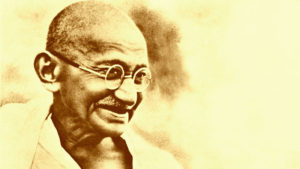
Mahatma Gandhi
As the year 2021 dawns, the world faces a whole range of problems including the COVID-19 pandemic, deep internal divisions in the US and other countries, persistent racism and casteism, sharp inequalities, rise of authoritarianism and fascism, climate change, environmental destruction, and so on. The situation is ripe for violence to erupt. In these dark times, I thought I should present a story of Mahatma Gandhi, the apostle of nonviolence. (This is also the 100th story on this website.)
People in many countries have struggled against dictatorships, discrimination, unjust laws, lack of freedom, and so on. In the twentieth century, over 300 struggles used nonviolent methods such as street protests, noncooperation, boycotts, and strikes. Over 240 of them were successful, including India’s freedom struggle. Mahatma Gandhi successfully used nonviolent methods to end the British Rule in India.
In 1893, early in his career as a lawyer, Gandhiji went to South Africa. There he saw that Indians, along with blacks, were being mistreated by the white government. The idea of nonviolence took root in his mind and he organized nonviolent action (or satyagraha) against the harsh laws imposed by the white government.
Gandhiji’s faith in nonviolence came from the Hindu idea of ahimsa (nonviolence towards all beings), the Bible, and books of the Russian writer Leo Tolstoy. He also got the idea of ‘Civil Disobedience’ (disobeying unjust laws in a peaceful way) from the work of American philosopher Henry David Thoreau.
Satyagraha is the name Gandhiji gave for nonviolent resistance. He combined the two Hindi words ‘truth’ and ‘holding firmly’. According to him, a satyagrahi (person practicing satyagraha) must firmly believe in truth and nonviolence. Satyagraha includes fasting, non-violent picketing, non-cooperation, civil disobedience, and willingness to bear police brutality and go to jail. But no matter how the satyagrahi is treated, he or she should not be violent or have hatred for his opponent.
In South Africa, when the white government ordered Indians to carry registration cards all the time, Gandhiji organized the people for civil disobedience. They set fire to their cards at a public place. Thousands of protesters were arrested. Gandhi himself went to jail thrice. Finally, the government withdrew the registration act along with other offensive laws.
Gandhiji returned to India in 1915 and was immediately drawn into the freedom movement. He led Indians in many nonviolent struggles against the British, but the most important one was the Salt March. At that time, only the government could manufacture salt. There was also heavy tax on salt. Gandhiji decided that he and other satyagrahis would march 250 miles from his ashram in Ahmedabad to the coastal village of Dandi. They would then break the law by making salt.
The March began on 12th March 1930 and lasted 24 days. On 6th April at Dandi, Gandhiji bent down and scooped up a handful of salt. Thousands of people made salt all along the coast and inland too. More than 100,000 were arrested across the country. Many were beaten by the police. No one resisted or retaliated.
People also followed Gandhiji’s other instructions: Hundreds of Indian officers resigned from their posts; many stopped paying taxes; British cloth was set on fire; thousands took to spinning cotton in their homes.
Gandhiji and other leaders were arrested and that only intensified the satyagraha. The government was shaken. In January 1931, the government released all the leaders. Gandhiji and the British Viceroy Lord Irwin signed an agreement. The government released all the prisoners and allowed salt manufacture on the coast. Gandhiji was invited to a conference in London to discuss the Indian demands. In return, Gandhiji called off the satyagraha.
At the London Conference, however, the British did not agree to give independence to India. In fact, the government in India began putting down protests very harshly. Should we say then that the Salt Satyagraha was not fully successful? No, it brought about a great change: It shook the British Empire. The Indian people realized their power and the British their weakness. This led finally to India’s Independence in 1947.
Gandhiji had shown how his methods of nonviolence could defeat a mighty country. His ideas influenced leaders such as Dr. Martin Luther King, Jr., in the US and Nelson Mandela in South Africa.
